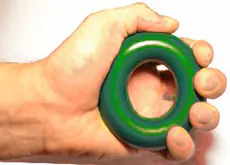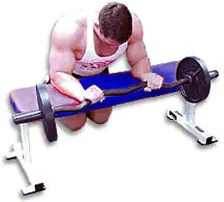Many beginners, and sometimes even experienced athletes, often forget about the rule of uniform pumping of the entire body. 
Often bodybuilders do not consider it necessary to train their arms with the same persistence as their chest or legs. Perhaps grip strength is not so important for them. But, for example, for wrestlers and athletes who perform in strength sports disciplines, a strong grip is simply vital.
In the gym you can hear the opinion that grip strength is influenced by the volume and width of the athlete’s forearm. Genetics undoubtedly influences hand strength, but without proper training, your grip will not become stronger. But it is the forearms that are the main “gear” in the mechanism of high-quality training of all muscle groups. After all, in almost all exercises we use the holding or squeezing function of our wrists. This article will tell you the secret of how to pump up your hands as quickly and efficiently as possible.
Grab.
For high-quality training of the palms and forearms, you do not need expensive exercise machines and special equipment. By changing different types of grips, you can pump up your hands. The main thing is a constant increase in load and progress in the intensity of the exercises. Strengthening your grip involves targeting all types of grip strength.
- The compressive grip force is responsible for a strong handshake.
- One of the most important purposes of a brush is to hold objects for a long time. Strengthening your grip holding strength will greatly benefit you in exercises such as deadlifts, chin rows, barbell rows, etc.
- The holding power of your grip is complemented by the strength of your wrists, which is also very useful when lifting objects.
Experienced bodybuilders, when planning a high-quality training of the hands, include exercises for all types of grip strength in the program. Intensive study of each functional feature of our brushes will allow you to achieve maximum results.
Exercises to develop compressive grip strength.
Of course, there are many ways to train this strength. The simplest, perhaps, is training with a wrist expander. You can easily purchase it at any sporting goods store. Start each session with exercises with an expander, gradually increasing the intensity and number of repetitions.
Let's use the wrist expander.
Here are a number of useful tips that, by adopting them, will help you greatly develop the compressive force of your palm:
- Never work with only one expander - because addiction is our worst enemy. It will be very good if you have several different ones in your arsenal: 3-4 pieces. Constantly alternate working on each of them.
- Constantly increase the load. If you “grow out” of a black rubber ring worn to holes, give it to someone weaker and buy yourself a new one. Professional brushes with adjustable load have proven themselves very well. However, this does not mean at all that having acquired such an expander, you can ignore the previous point. Treat yourself to some rubber from time to time.
- Constantly change your grip, this is especially true for hand grips with a handle that affects all fingers unevenly. Such samples need to be constantly turned up and down.
- Change and vary your stationary wrist position. That is, first bend your wrist (and your entire palm with the apparatus), and perform presses in this starting position. In the next approach, do the opposite - straighten your wrist, and let's press...
- Simultaneously with the expander presses, perform all kinds of rotations of the hand: pronation and supination, as well as flexion and extension, just as in the previous paragraph, only with each iteration.
By adopting all the tips described above, you will pump up your palms much faster and more efficiently.
Exercises to develop holding grip strength.
In general, the compressive and holding forces of the grip go hand in hand. Here the same wrist expanders discussed above and practically the same techniques and tricks will help us, with the only difference that when performing approaches you need not to squeeze and unclench the wrist expander, but to use statics: squeeze the expander and, overcoming its resistance, try to hold it longer in such a compressed state. Better yet: suddenly alternate cyclic presses with static holds - in short, surprise your muscles!
Thick barbell.
In addition to wrist expanders, you need to use a thick bar in order to further pump up your forearms. A thick bar significantly increases the load on the hands: it is more difficult to keep under control. Using such a bar will initially seem painfully inconvenient to you. You can compare the sensations of beginners with a feeling similar to pulling a “telegraph pole” instead of a bar. However, doing wrist curls will improve all types of grip strength.
Correct technique for performing the exercise.- Take a thick bar and stand in front of a horizontal bench in a kneeling position. Your hands should be placed with your forearms on the bench parallel to each other. Palms should face up. You need to position yourself on the bench so that your wrists extend beyond the edge of the bench and it does not interfere with their movements. While performing the movements described below, your body should be completely motionless, only your wrists working. It is not necessary to squeeze the bar tightly in your hands; you can allow it to roll freely.
- Initially, straighten your wrists and gently lower them down. Movements should be performed smoothly, without sudden lifting. Then try to raise your hands as high as possible... After a few repetitions, you will feel tension in the inner forearm.
- And the third main feature when performing this exercise is breathing. Be sure to exhale sharply when lifting the bar, and when the bar is lowering, inhale smoothly.
- In the starting position, your arms should be absolutely straight and your ligaments should be as tight as possible. It’s difficult to immediately get into the correct position; you need to fidget around the bench a little in search of a comfortable position.
- In no case should you lift your forearms off the bench, as then the entire load will go away from the wrists and forearms, and at the same time transfer to the biceps.
- To increase the range of motion, you need to learn to hold the bar “lightly” and without straining. The free movement of the bar will allow you to fully extend your wrists at the bottom of the exercise.
Hand strengthener exercise machine.
Of course, we couldn’t help but tell you about such a wonderful invention of mankind as a hand strengthener. Read more about this simulator here. All its charm lies in its extremely simple design. If you wish, you can build it at home with your own hands. Working on it is incredibly simple: you only need to use the force of your palms and forearms to wind the cable, raising the load, and then unwind it, lowering it accordingly. Try to eliminate all possible manifestations of cheating.
Reverse biceps.
When working with dumbbells on the biceps brachii muscle, be sure to add such an effective exercise as reverse biceps to your training plan:
- Starting position: the fingers of your palms with clamped dumbbells rest against your hips, that is, your palms are turned towards you.
- We alternately lift the biceps, while rotating the hand so that at the top point of the amplitude the fingers (and palms) again turn towards you (toward your face)
- Moving down in the opposite direction, we rotate again to reach the starting position described above.
Reverse trains the pronator and supinator muscles, which also affect the strength and power of the hand.
Hammer grip and Zotman curls.
A certain analogue of the previous exercise is Zotman. It is also very effective and does not allow our muscles to get used to routine monotony:
- We hold the dumbbells as we usually hold a hammer.
- In this position of the palms and clamped implements, we perform biceps curls.
- Apart from the grip, this variation is not really different from regular biceps curls.
Armwrestling techniques.
Armwrestling athletes, for whom the hands and forearms are, in fact, the most important muscle groups on which victory or defeat directly depends, in addition to all of the above, use other training methods and techniques:
- Training with special equipment. For example, a dumbbell with a long handle and collapsible weights, but only on one side. The athlete takes the projectile like a hammer and performs all sorts of rotations and tilts of the hand from various positions at different angles, including those discussed above: pronation, supination, adduction and abduction of the wrists.
- Working with block devices. Usually this is a kind of symbiosis of a cattle shop and a block frame. The arm wrestler sets his shoulder in various positions (dominant, inferior or neutral) and fights not only with another athlete, but with the handle of the block device, initially hanging the load to his liking.
- Training with a sparring partner. Nothing will test your readiness to fight more than a real fight with an opponent just like you. And, if you can skip some angle on the simulators and not pump it up, this will immediately come up eloquently in the fight. Therefore, armwrestlers regularly compete with each other, trying to choose a stronger opponent... So you, too, periodically fight with one of your friends or relatives...
Here are a couple more points that are worth paying your close attention to:
- A very important aspect of any body training is proper sports nutrition. In order for your forearms to grow and your wrists to become stronger, after each workout it is recommended to drink a protein-carbohydrate mix, in which 1/5 will be protein.
- Don't be afraid to overdo it, as with other muscle groups. Because the palms and forearms belong to the group of so-called “difficult” or “stubborn” muscles. They respond very poorly to load. Therefore, they need to be constantly shocked and bombarded to the fullest. It is for this reason that many athletes always keep a handgun in the pocket of their outerwear. When a free minute appears, they take an approach or two. Moreover, the more often the better! It is almost impossible to pump these muscles.
- If you don't see significant growth in your forearms after a while, you should slightly limit the stress on your palms outside the gym.
Targeted training of the hands is a complex process, but achievable. Exercise regularly, and you can pump up your palms and forearms, like Hercules! And let all the men you know be afraid of your handshake, and let no one even risk sitting at the arm wrestling table with you!



